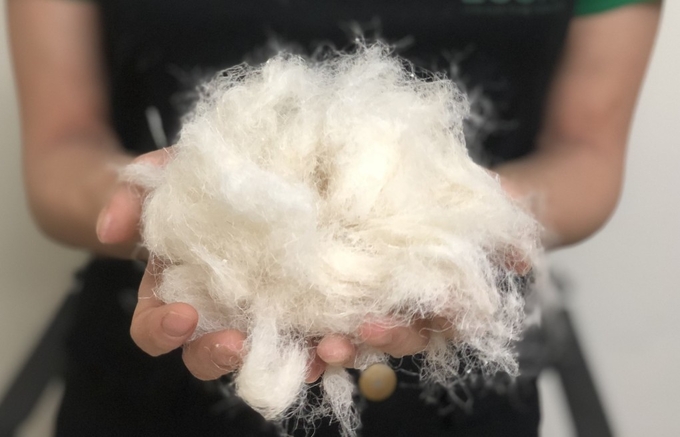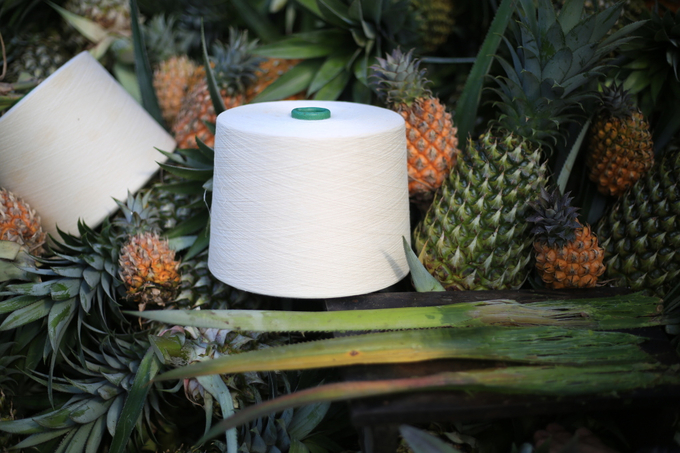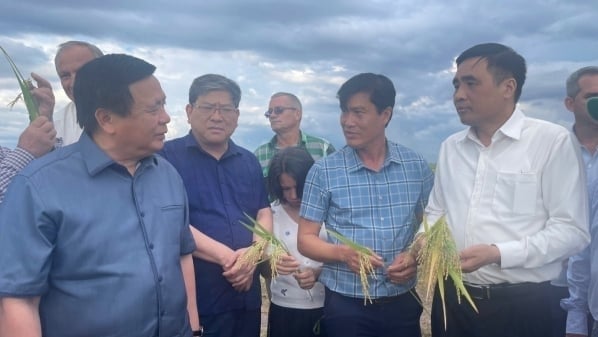May 18, 2025 | 11:36 GMT +7
May 18, 2025 | 11:36 GMT +7
Hotline: 0913.378.918
May 18, 2025 | 11:36 GMT +7
Hotline: 0913.378.918

Silk is produced from pineapple leaves.
For the first time in Vietnam, there is a company that produces textile materials from pineapple leaves on a mass scale, with an output of 18 tons of fiber per month.
Cooperating with farmers and cooperatives in Dien Bien, Ninh Binh, Thanh Hoa, Nghe An, and Tien Giang to harvest pineapple leaves, startup Ecofa Vietnam turns them into silk and yarn for the textile industry. It results from more than three years of research and testing by this company.
The process of producing raw fiber and cottoning pineapple leaf fiber goes through 18 stages. Still, it includes separating raw pineapple fiber (same color & length) from the leaves, then cottoning the raw fiber into silk (ensuring uniform color, moisture, length & thinness). At this time, pineapple silk is used to spin yarn and weave fabric.
Founder and engineer Dau Van Nam said that producing fiber from pineapple leaves is not new, but in the past, it was only in the traditional, small-scale form. Manual methods of spinning long fibers cannot produce enough silk output to enter the spinning and weaving factories. "We don't want to miss the opportunity to be the first," he said.
So, in mid-2021, he began testing pineapple silk production using a machine he had invented. "The process of producing pineapple silk on a large scale using a machine was gradually perfected through many years of failed experiments," Nam admitted.
During this process, the startup found a like-minded partner, Bao Lan Textile, a unit specializing in the field of R&D of ecological fabrics. They joined hands in the past 3 years to complete the entire chain of processing post-harvest waste, including pineapple leaves and fruits, into fabric that can be used to make clothes.
By the beginning of this year, Ecofa was able to supply 18 tons of silk (pineapple cottonized fiber) from more than one million tons of pineapple leaves harvested each month. The company expects the output to increase to 50 tons per month by the end of 2025.
This source of raw materials from Ecofa will be provided to Bao Lan Textile to weave into the fabric for the textile, garment, fashion, and interior industries under the brand name Ananas. Depending on the purpose of use, pineapple leaf silk is custom-blended with other ecological fibers such as organic cotton, bamboo biocell (a type of young fiber produced using closed-loop system technology), silk, and wool.
From there, they can create materials such as jeans, elastic, towels, woven fabrics, and knitted fabrics. "Pineapple yarn is a material that already exists, but we have developed it together as a new brand with an entrepreneurial spirit," said Dave Quach, Founder of Bao Lan Textile.

Finished fiber produced from pineapple leaves.
The Vietnam Textile Research Institute JSC (VTRSI-TTC) in Ho Chi Minh and the Nissenken Quality Evaluation Center (Japan) have certified four features of pineapple leaf fabric developed by these two startups, including fabric durability, natural deodorization on fibers, natural antibacterial on fibers, natural UV protection on silk up to 50+UPF.
According to experts in the textile industry, pineapple fabric was known around the 17th century, most commonly in the Philippines. However, all the stages of making the fabric were complicated, and only rudimentary tools were used, so the output was low, making the price expensive and rarely used. This material was forgotten when cheap industrial textiles became popular after the 19th century.
However, the green consumption trend has promoted a wave of startups, helping to "revive" pineapple leaf fabric for widespread application in today's life. Some countries, such as the Philippines, Costa Rica, and Bangladesh, have also recently researched and commercialized pineapple fiber.
Nguyen Thi Tuyet Mai, Deputy General Secretary of the Vietnam Textile and Apparel Association (VITAS), said that the type of fiber and fabric introduced by these two startups marks a turning point connecting the pineapple farming industry and the global green fashion trend.
"In the context that the domestic and global textile and garment industries still lack raw materials for production towards green fashion, the two companies' success in researching and mass-producing, closed-loop pineapple fiber of sufficient quality for garment fabrics has a positive impact on the demand and development of the industry, not only in Vietnam," Mai said.
According to the forecast of the market research company The Business Research Company (UK), the world natural fiber market will grow from USD 63.62 billion in 2021 to USD 77.12 billion in 2026. Founder Dave Quach said that fabric from pineapple leaves has good export prospects. His company is negotiating with many foreign purchasing partners and cannot announce more details at this time.
Translated by Huong Giang

(VAN) Deputy Minister Nguyen Quoc Tri also expressed his hope that Cuba will soon overcome its current challenges, attain food security, and further expand cooperation with Vietnam.

(VAN) The project contributes to enhancing the resilience of communities vulnerable to the impacts of climate change, with a primary focus on local women.

(VAN) Green materials help save energy and resources. However, after more than 10 years, Vietnam has only developed over 200 green buildings with more than 6 million square meters of floor space.

(VAN) Vietnam - Thailand Business Forum 2025: One plus one on three connects, marking a milestone in the comprehensive strategic partnership between the two nations.

(VAN) The United Nations designated 22 May as the International Day for Biodiversity 2025 with the theme 'Harmony with nature and sustainable development.'
![Multi-channel, multi-directional Vietnamese agricultural markets: [8] A national strategy is needed](https://t.ex-cdn.com/nongnghiepmoitruong.vn/608w/files/phucpm/2025/05/15/1435-thi-truong-nong-san-viet-da-kenh-da-huongbai-8-can-mot-chien-luoc-quoc-gia-084750_728.jpg)
(VAN) The Chairman of Hung Nhon Group shared: ‘Opening up and tapping into new markets is the right and strategic direction for Vietnam's agricultural sector.’

(VAN) Food waste has become a serious issue in modern society, especially in rapidly urbanizing and developing cities like Hanoi.